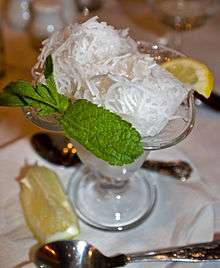Faloodeh
 | |
| Alternative names | Faludeh, Paloodeh, Paludeh, Fālūdhaj |
|---|---|
| Type | Dessert |
| Course | Lunch & Dinner |
| Place of origin |
Shiraz, |
| Main ingredients | Vermicelli, syrup (sugar, rose water) |
Faloodeh (Persian: فالوده, translit. fālūde) or paloodeh (Persian: پالوده, translit. pālūde) is a traditional Iranian cold dessert similar to a sorbet.[1][2] It consists of thin vermicelli-sized noodles made from starch in a semi-frozen syrup containing sugar and rose water.[3][4][5] Faloodeh is often served with lime juice and sometimes ground pistachios.
In Iran, faloodeh is sold in ice cream stores and coffee shops in flavors such as pistachio, saffron, rosewater and honey, and can be served alongside Persian-style ice cream.[6][7]
History
Faloodeh originated in Shiraz and is sometimes known as Shirazi faloodeh (Persian: فالوده شیرازی, translit. fālūde Shirāzi) in Iran.[8]
The word paloodeh is from the verb paloodan (Persian: پالودن) which means to refine. Faloodeh is an Arabicized form of paloodeh that appeared after the Arab conquest of Iran, due to a lack of the phoneme /p/ in Standard Arabic.[9][10][11]
In the 16th to 18th centuries, the Indo-Persian Mughal kings who ruled the Indian subcontinent created a cold dessert beverage called falooda which is a derivative of faloodeh. [12]
Preparation
A thin batter of starch (from potatoes, arrowroot, maize, or rice) is cooked, then pressed through a sieve producing delicate strings similar to cellophane noodles, that are then chilled in ice water.[3][4] Afterwards, they are combined with the syrup mixture and rapidly cooled until the syrup is at least half-frozen.
See also


References
- ↑ Dan Jurafsky (November 16, 2011). "Macarons, Macaroons, Macaroni: The curious history". Slate.
- ↑ Krondl, Michael (2011). Sweet invention : a history of dessert. Chicago, Ill: Chicago Review Press. ISBN 1-55652-954-6. page 102.
- 1 2 "Recipe: Faloodeh (Persian Rose Water Ice)". Kitchn. Retrieved 2017-06-12.
- 1 2 Dalal, Tarla (2000-09-01). Chaat Cookbook. Sanjay & Co. p. 96. ISBN 9788186469620.
- ↑ Sinaiee, Maryam (2015-05-10). "Faloodeh: Persian Rosewater and Lemon Sorbet". The Persian Fusion. Retrieved 2017-06-12.
- ↑ Marks, Gil (2010-11-17). Encyclopedia of Jewish Food. Wiley. ISBN 9780470943540.
- ↑ "what is faloodeh en how to make it?". Bastani Tehran. Retrieved 2017-06-12.
- ↑ "SHIRAZ SIGHTS at Best Iran Travel.com". www.bestirantravel.com. Retrieved 2017-06-12.
- ↑ Spooner, Brian (1994). "Dari, Farsi, and Tojiki". In Marashi, Mehdi. Persian Studies in North America: Studies in Honor of Mohammad Ali Jazayery. Leiden: Brill. pp. 177–178.
- ↑ Spooner, Brian (2012). "Dari, Farsi, and Tojiki". In Schiffman, Harold. Language policy and language conflict in Afghanistan and its neighbors: the changing politics of language choice. Leiden: Brill. p. 94.
- ↑ Campbell, George L.; King, Gareth, eds. (2013). "Persian". Compendium of the World's Languages (3rd ed.). Routledge. p. 1339.
- ↑ "The Dessert of the Kings - Falooda | Whats Ur Home Story". Whats Ur Home Story. 2016-02-10. Retrieved 2017-06-12.